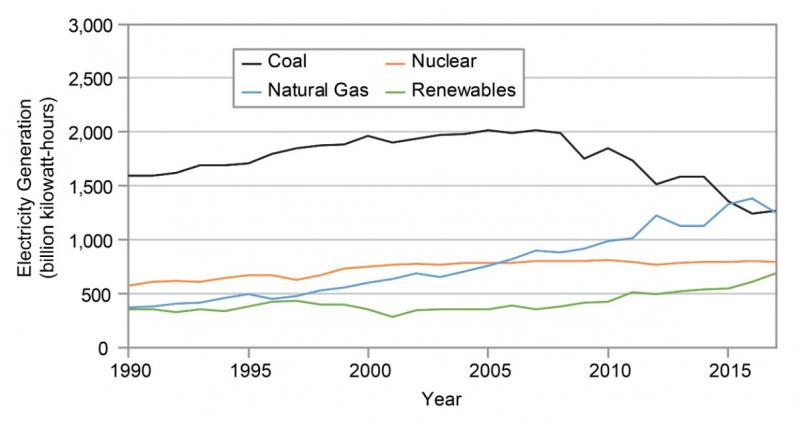Energy Production
Changes in the Energy System
In 2016, natural gas replaced coal as the leading source of electricity generation in the United States, and net imports of petroleum reached a new low. New drilling technologies (mainly hydraulic fracturing or "fracking") have increased natural gas production, lowered prices, and enabled greater consumption.
Dramatic reductions in the cost of renewable generation sources have led to the rapid growth of solar and wind installations. In the United States during 2016, energy generated by solar sources grew by 44%, and wind generation grew by 19%.
These changes offer the opportunity to diversify the energy generation portfolio, yet they require planning for reliable and resilient operations. Natural gas generation generally improves electric system flexibility and reliability, as gas-fired power plants can ramp up or down quickly in response to use. However, gas supplies and the systems that transport them are vulnerable to different hazards than the systems that provide coal. Additionally, solar and wind installations are exposed to different hazards than coal and gas power plants.
The growing adoption of energy efficiency programs, demand response programs, transmission capacity increases, and microgrids with energy storage technologies is enhancing system flexibility, reliability, and resilience.
This section is excerpted and abridged from the report Impacts, Risks, and Adaptation in the United States: Fourth National Climate Assessment, Volume II (Chapter 4:Energy Supply, Delivery, and Demand).
Environmental changes
Decreased precipitation, increased evapotranspiration, and increased temperatures associated with climate change may decrease energy production in some regions. Production of electricity from fossil fuels, nuclear power, and hydropower requires adequate supplies of water. For generation methods that require steam, it takes about 25 gallons of water to generate 1 kWh of electricity. Water withdrawals for power plants represent the largest demand for fresh water in the United States, accounting for up to 41 percent of withdrawals in some regions. If water supplies are limited, the supply of electricity will be as well.
Hydroelectric power also requires sufficient water: reservoir levels must be high enough to provide the hydraulic head (liquid pressure) that drives turbines to generate electricity. Models suggest that a one percent decrease in precipitation would decrease water supplies enough to decrease hydropower generation by three percent. Changes in streamflow during different seasons may also reduce generation of electricity in the West because the hydropower process relies on seasonal snowmelt to provide steady outputs throughout the year.
Climate change is expected to result in decreased precipitation in at least one season for many regions of the United States, resulting in smaller volumes of water in streams and reservoirs. In the Northwest and Southwest, expected decreases in the portion of precipitation that falls as snow in the winter as well as drier conditions in the summer may also decrease summer stream flows. In all regions, increased temperatures will increase the rate of evapotranspiration, leading to a decrease in surface water supplies in rivers and reservoirs.
Increases in water and air temperatures also reduce the efficiency of electricity production. For thermoelectric power plants, a lack of cold water can decrease cooling efficiency, reducing capacity for electricity production. Increased water temperatures could reduce efficiency at these plants by one percent: this translates to a national decrease of 25 billion kWh each year that would need to be replaced by other sources. Elevated air temperatures can also affect certain types of electricity generation systems. For instance, a 10°F increase in air temperature can decrease efficiency of gas turbine electricity generation by three to four percent. Electricity generation by air-cooled geothermal energy sources may also be affected by higher air temperatures.
This section is excerpted and abridged from the report Climate Change Impacts in the United States: The Third National Climate Assessment (Chapter 2: Our Changing Climate, Chapter 3: Water Resources, and Chapter 4: Energy Supply and Use) and the report Effects of Climate Change on Energy Production and Use in the United States (PDF).



